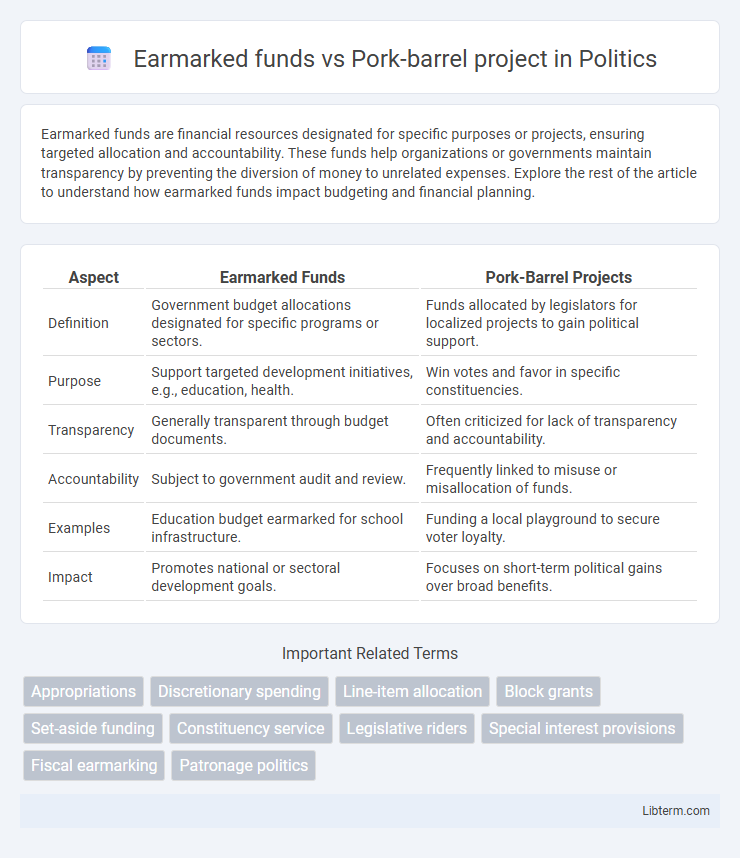Earmarked funds are financial resources designated for specific purposes or projects, ensuring targeted allocation and accountability. These funds help organizations or governments maintain transparency by preventing the diversion of money to unrelated expenses. Explore the rest of the article to understand how earmarked funds impact budgeting and financial planning.
Table of Comparison
| Aspect | Earmarked Funds | Pork-Barrel Projects |
|---|---|---|
| Definition | Government budget allocations designated for specific programs or sectors. | Funds allocated by legislators for localized projects to gain political support. |
| Purpose | Support targeted development initiatives, e.g., education, health. | Win votes and favor in specific constituencies. |
| Transparency | Generally transparent through budget documents. | Often criticized for lack of transparency and accountability. |
| Accountability | Subject to government audit and review. | Frequently linked to misuse or misallocation of funds. |
| Examples | Education budget earmarked for school infrastructure. | Funding a local playground to secure voter loyalty. |
| Impact | Promotes national or sectoral development goals. | Focuses on short-term political gains over broad benefits. |
Understanding Earmarked Funds: Definition and Purpose
Earmarked funds refer to government revenues or budget allocations designated for specific projects, programs, or purposes, ensuring targeted spending and financial accountability. These funds are often used to finance infrastructure, education, or health initiatives with transparent legislative approval. By contrast, pork-barrel projects typically involve localized spending that benefits a legislator's district, sometimes criticized for lacking broader public interest or strategic planning.
What Are Pork-Barrel Projects?
Pork-barrel projects refer to government spending directed toward localized projects secured primarily to bring money to a representative's district, often to gain political support rather than address broader public needs. These projects typically involve funding allocations embedded within larger bills, benefiting specific constituents or interest groups rather than the public at large. Unlike earmarked funds, which are designated with a clear purpose and oversight, pork-barrel projects often lack transparency and can be criticized for fostering wasteful spending and patronage.
Key Differences Between Earmarked Funds and Pork-Barrel Projects
Earmarked funds are specific budget allocations designated by the legislature for particular programs or projects, ensuring transparent and accountable use of resources, often based on predetermined criteria or public priorities. Pork-barrel projects, on the other hand, refer to localized government spending intended to benefit a legislator's constituents primarily to gain political support, typically characterized by discretionary and less transparent allocation. The key differences lie in the purpose, transparency, and legislative intent, with earmarked funds focused on policy-driven funding and pork-barrel projects aimed at political gain.
Historical Origins of Earmarking and Pork-Barrel Spending
Earmarked funds trace their origins to the early U.S. Congress in the 19th century, designed as specific budgetary allocations for local projects that ensured regional representation and political support. Pork-barrel spending emerged as a pejorative term describing the practice of legislators securing government funds for localized projects to win favor from constituents, often linked to patronage and political bargaining. Both concepts evolved from the interplay between federal budget control and localized political interests, shaping U.S. legislative appropriations over time.
Legal Framework: How Earmarked Funds Are Allocated
Earmarked funds are allocated through strict legal frameworks that define specific revenue sources and dedicated purposes, often enshrined in national or local government budgets to ensure transparency and accountability. These allocations are governed by laws or statutes that specify the use of the funds, preventing diversion to unrelated projects and enabling targeted spending on public goods such as education, health, or infrastructure. In contrast, pork-barrel projects typically lack such formal legal constraints and are often distributed at the discretion of legislators, raising concerns about favoritism and misuse of public resources.
Political Implications of Pork-Barrel Projects
Pork-barrel projects often serve as tools for politicians to secure voter loyalty and channel public resources to specific interest groups, leading to patronage and clientelism. Unlike earmarked funds that are designated transparently for specific purposes, pork-barrel allocations may lack accountability, fostering corruption and inefficiency in public spending. Politically, pork-barrel projects can consolidate power within local constituencies, influencing electoral outcomes and policy priorities through targeted financial incentives.
Transparency and Accountability in Fund Allocation
Earmarked funds are designated for specific projects or sectors with clear guidelines and reporting requirements, enhancing transparency and accountability in fund allocation. Pork-barrel projects often involve discretionary spending without stringent oversight, leading to potential misuse and reduced transparency. Transparent earmarked funds ensure that public money is tracked and utilized for intended purposes, fostering greater accountability in government spending.
Real-world Examples: Earmarked Funds vs. Pork-Barrel Projects
Earmarked funds are specific budget allocations designated for particular projects, such as the U.S. federal government's highway trust fund dedicated to transportation infrastructure, ensuring targeted use of resources. Pork-barrel projects, like the infamous "Bridge to Nowhere" in Alaska, often arise from efforts to secure localized spending with political motives, sometimes resulting in controversial or inefficient expenditures. Real-world examples demonstrate earmarked funds' role in structured development versus pork-barrel projects' association with political bargaining and region-specific gains.
Advantages and Disadvantages of Each Funding Mechanism
Earmarked funds ensure targeted allocation of resources to specific sectors such as education or infrastructure, promoting transparency and efficient budget planning but can limit flexibility for governments to reallocate funds during emergencies. Pork-barrel projects, often driven by legislators' interests to benefit local constituencies, can accelerate regional development and address localized needs, though they risk fostering nepotism, misallocation, and reduced national budget coherence. While earmarked funds enhance accountability and strategic priorities, pork-barrel spending may encourage political favoritism and inefficiencies in public expenditure.
Reforms and the Future of Public Fund Allocation
Earmarked funds ensure transparency by allocating specific budget portions to predefined sectors, minimizing misuse through stringent regulatory reforms. Pork-barrel projects often lack clear accountability, prompting ongoing legislative efforts to eradicate discretionary allocations and promote merit-based public fund distribution. Future public fund allocation emphasizes data-driven approaches and participatory budgeting to enhance fiscal responsibility and equitable resource allocation.
Earmarked funds Infographic

 libterm.com
libterm.com